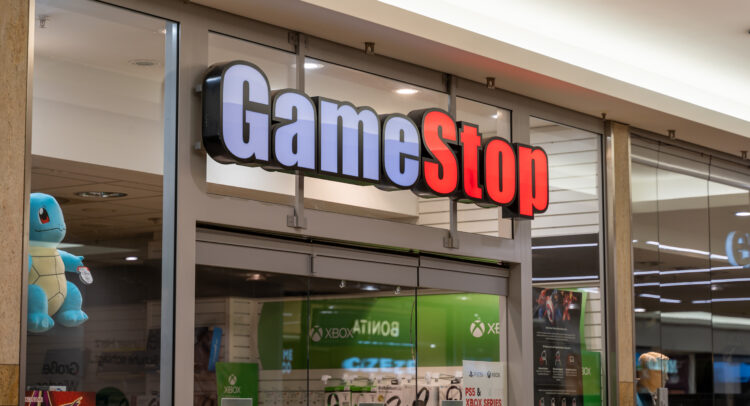GameStop (GME), a brick-and-mortar video game retailer and infamous meme stock, saw its share price plunge after reporting second-quarter financial results that showed its sales declined 31% year over year. However, a $4 billion cash pile may distract investors from the company’s significant challenges.
Elevate Your Investing Strategy:
- Take advantage of TipRanks Premium at 55% off! Unlock powerful investing tools, advanced data, and expert analyst insights to help you invest with confidence.
Investors should keep in mind that a highly anticipated turnaround at GameStop has yet to materialize and no amount of cash can takeaway from the fact that GME stock is a risky investment. There is zero evidence that GameStop plans to use its massive cash pile to reward shareholders with stock buybacks or a dividend payment. On the contrary, the company just announced plans to sell an additional 20 million shares, further diluting the holdings of existing stockholders. For these reasons, I am extremely bearish on GameStop stock.
GameStop’s Operational Challenges
My bearish stance on GameStop stock is largely based on the company’s continued inability to improve its operating metrics. While the company did report a surprise net profit of $14.8 million for Q2, its sales declined more than 30%, continuing a downward trend as consumers increasingly purchase video games online rather than at retail stores.
But even the company’s profit is suspect. A closer look shows that the profit came on the back of $39.5 million of interest income, which offset an operating loss of $28.4 million. The $4 billion cash pile paved the way for this substantial interest income, but this in no way represents an improvement in the company’s business operations.
In Q2 of this year, GameStop’s hardware sales declined 24.5% from a year ago to $451 million, while software sales plunged 48% to $208 million. Collectibles fell 18% from a year earlier. It was the fourth consecutive quarter of total revenue decline at GameStop, highlighting the company’s inability to capture new business.

A Difficult Macroeconomic Environment for GameStop
Another reason to be bearish on GME stock is that the company is operating in a difficult macroeconomic environment. GameStop’s continued sales decline is due to two developments. First, the gaming market is moving rapidly to digital downloads, resulting in less foot traffic at GameStop’s physical store locations. In 2020, digital game sales surpassed physical sales for the first time. Since then, digital downloads have grown to account for more than 80% of the industry’s sales.
Second, GameStop faces increasing competition from subscription services such as the Xbox Game Pass from Microsoft (MSFT) and PlayStation Now from Sony (SONY). These subscription services have gained ground at the expense of retailers. There were 34 million Xbox Game Pass subscribers at the end of 2023, a 34% increase from 25 million subscribers in 2021. With more games being offered exclusively to subscribers of these services, GameStop’s relevance continues to decline.
GME Stock Dilution
As mentioned, GameStop continues to dilute shareholders, which is a big red flag and yet another reason for my bearish view of the company and its stock. Since the original meme stock mania of 2021, GameStop has capitalized on every opportunity when its stock price rises to issue additional shares and raise capital. These stock issues have contributed to the $4 billion cash pile at the expense of shareholders. Below is a timeline of GameStop’s stock issuances.
- June 2021: GameStop sold five million shares for $1.13 billion in gross proceeds.
- May 2024: The company sold 45 million shares to raise $933.4 million.
- June 2024: GameStop sold 75 million shares, generating $2.14 billion.
GameStop’s capital raise has failed to yield any positive returns for the company or its shareholders. So far, none of the funds have been used to support a turnaround plan. This inefficient use of capital exposes a major risk to shareholders as the business may eventually go bankrupt and cease operations.
GameStop’s Potential Options
While I remain bearish on GameStop, the company does have some options to revive growth and turnaround its business. The company could employ its $4 billion cash pile to invest in a strategic business transformation. One of the most efficient ways to use the cash would be to acquire non-gaming businesses and gain exposure to new and different markets.
GameStop may also consider transforming itself into an e-commerce operation. In the past, management at the company has said that they want GameStop to become the “Amazon of gaming.” Sadly, the company has chosen the simple yet ineffective strategy of investing in treasury markets to generate interest income. Although treasuries have boosted the company’s short-term financial performance, once interest rates decline, the market is likely to punish the company.
Is GameStop a Buy, According to Wall Street Analysts?
Owing to its notorious meme stock past, most Wall Street analysts have abandoned GME stock. Currently, there is only one analyst rating on GameStop’s shares, and it is a Sell. That one analyst has a price target on the stock of $10, implying a downside risk of 51.55% from the current market price.

Conclusion: Avoid GameStop Stock
GameStop is struggling with declining sales and is operating in an unfavorable macroeconomic environment. Worse, the company’s management team is failing to address the changing video game market, and a $4 billion pile of cash has not been put to efficient use. With a recovery increasingly unlikely, GameStop’s stock looks like a bad bet. Investors should stay away.
















